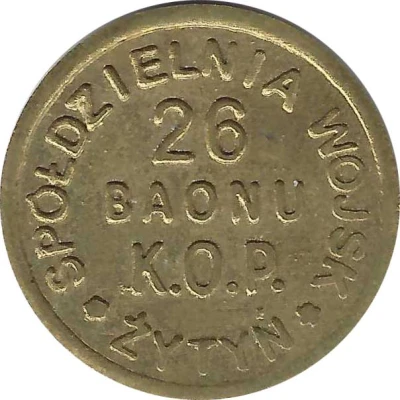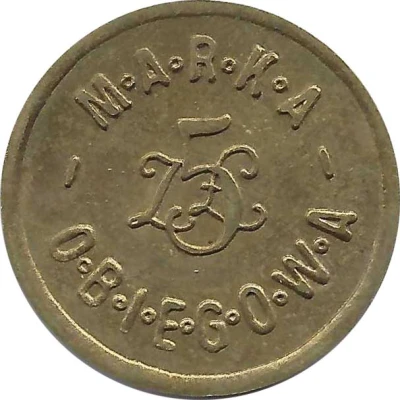


© l.gringo.n (CC BY-NC-SA)
5 Zlotych - Spoldzielnia 26 Baony K.O.P Zytyn ND
| Brass | 7.46 g | 25.55 mm |
| Issuer | Polish notgeld (Poland) |
|---|---|
| Type | Token |
| Years | 1925-1939 |
| Value | 5 Zlotys (5 Złotych) |
| Composition | Brass |
| Weight | 7.46 g |
| Diameter | 25.55 mm |
| Thickness | 2.01 mm |
| Shape | Round |
| Technique | Milled |
| Orientation | Medal alignment ↑↑ |
| Demonetized | Yes |
| Updated | 2024-10-07 |
| Numista | N#240287 |
|---|---|
| Rarity index | 95% |
Reverse
Script: Latin
Lettering:
M.A.R.K.A
5
ZL
O.B.I.E.G.O.W.A
Edge
Plain
Comment
Credit token of the Polish Republic of the interwar period.After the end of the fighting with Soviet Russia, Polish units were stationed in places of permanent deployment and in most of them began to create cooperatives, in which, as shareholders were officers, non-commissioned officers, and in some units privates and even freelancers. to the Union of Military Cooperatives.
Military cooperatives needed not only to open their stores, which could provide shareholders with products and goods at fixed prices, but also to provide credit. In the absence of credit in the cooperative, its members would apply for purchases on credit to private sellers.
Credit in the cooperative was organized in the form of credit token, the amount of which was recorded in the book, and these token cooperative shop, workshop sold goods, products, services. Upon receipt of salary, each shareholder repaid his debt and he was again issued credit token (returned from shop in the board of the cooperative) with an entry in the book.
Thus, there was a repeated circulation of token, which rotated only within the cooperative of this military unit.
Credit token were paper and metal. Metal stamps were more profitable, as they were less worn out in circulation, so very few paper credit token have survived to this day (they were burned after cancellation) and a large number of metal ones.
The token, in addition to the face value, indicated the number and name of the military unit (not always) and occasionally the year of issue.
Some military cooperatives during the period of credit token (1925-39) changed them, ordering new sets of another type. The reasons could be different, including a significant loss, or the detection of a significant number of counterfeit stamps. Sometimes the replacement of paper token worn on metal. And finally, the replacement of token with the name or number of a military unit with token with the conditional name of the cooperative in order to preserve military secrecy, a few years before the German attack.
In addition to token with the inscription cooperative (SPOLDZIELNIA) and which were intended for purchases in the cooperative store, many divisions issued token for clubs (officers and non-commissioned officers), casinos, canteens, teahouses and other establishments.
The main place for the production of metal token for military cooperatives was the workshop of Bronislaw Grabski in Łódz. It produced the vast majority of metal issues. token and only the token of the front side had to be cut for each unit separately.
The most popular was a set of four denominations - 10,20,50 grosz and 1 zloty. Some ordered two- and five-zloty. token with a face value of 5 grosz, they were also minted, but they had only the inscription "military cooperative" and 5 grosz , so they could be used in any of the cooperatives.
Interesting fact
One interesting fact about the Token 5 Zlotych - Spoldzielnia 26 Baony K.O.P (Zytyn) ND (1925-1939) from Polish notgeld (Poland) made of Brass weighing 7.46 g is that it was used as a form of emergency currency during a time of economic crisis in Poland. The coin was issued by the Polish government in 1925 as a response to a severe shortage of small denomination coins, which had led to a bartering system and the use of foreign currencies. The Token 5 Zlotych was made of brass and had a unique design, featuring the image of a farmer and a soldier on one side and the value of the coin on the other. It was used widely throughout Poland and was accepted as legal tender until the outbreak of World War II in 1939. Today, the Token 5 Zlotych is a rare and highly sought-after collector's item among numismatists.